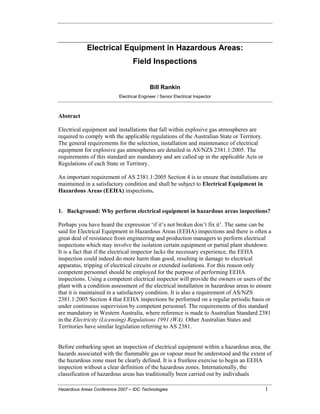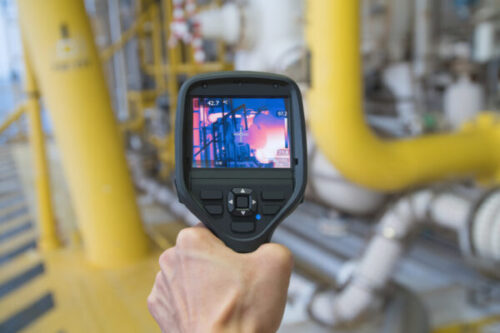Roar Solutions for Dummies
Roar Solutions for Dummies
Blog Article
Indicators on Roar Solutions You Should Know
Table of ContentsEverything about Roar SolutionsThe Ultimate Guide To Roar SolutionsSome Ideas on Roar Solutions You Need To Know
In order to safeguard installations from a possible surge a technique of analysing and identifying a possibly harmful area is required. The purpose of this is to make certain the right selection and installation of tools to inevitably stop an explosion and to guarantee safety of life.
(https://www.bark.com/en/au/company/roar-solutions/Bz3O1R/)
No equipment ought to be set up where the surface area temperature level of the tools is greater than the ignition temperature of the provided risk. Below are some typical dirt harmful and their minimal ignition temperature level. Coal Dirt 380C 225C Polythene 420C (thaws) Methyl Cellulose 420C 320C Starch 460C 435C Flour 490C 340C Sugar 490C 460C Grain Dirt 510C 300C Phenolic Resin 530C > 450C Aluminium 590C > 450C PVC 700C > 450C Soot 810C 570C The chance of the threat existing in a focus high sufficient to create an ignition will certainly vary from place to location.
In order to categorize this risk an installation is divided into locations of threat depending upon the amount of time the unsafe exists. These locations are described as Areas. For gases and vapours and dirts and fibres there are three zones. Area 0 Area 20 A hazardous environment is highly likely to be present and may be present for extended periods of time (> 1000 hours annually) and even constantly Zone 1 Zone 21 A hazardous atmosphere is feasible yet not likely to be existing for extended periods of time (> 10 450 C [842 F] A classification of T6 means the minimal ignition temperature level is > 85 C [185 F] Hazardous area electrical tools perhaps made for usage in higher ambient temperature levels. This would certainly indicated on the ranking plate e.g. EExe II C T3 Ta + 60C( This indicates at 60C ambient T3 will not be exceeded) T1 T1, T2, T3, T4, T5, T6 T2 T2, T3, T4, T5, T6 T3 T3, T4, T5, T6 T4 T4, T5, T6 T5 T5, T6 T6 T6 A T Course score of T1 means the optimum surface area temperature created by the instrument at 40 C is 450 C. Thinking the connected T Course and Temperature rating for the tools are suitable for the location, you can always use a tool with a more rigid Division score than required for the area. There isn't a clear solution to this inquiry sadly. It actually does depend on the type of tools and what fixings require to be performed. Tools with certain test procedures that can't be performed in the field in order to achieve/maintain 3rd party score. Should return to the manufacturing facility if it is prior to the devices's solution. Area Repair Work By Authorised Employee: Complicated testing might not be required nevertheless specific treatments might need to be followed in order for the equipment to keep its 3rd event score. Authorised employees have to be employed to carry out the job appropriately Repair work need to be a like for like substitute. New part must be thought about as a straight substitute calling for no unique screening of the equipment after the repair work is total. Each tool with a dangerous score must be reviewed independently. These are outlined at a high level listed below, but for more in-depth details, please refer straight to the standards.
Get This Report about Roar Solutions
The tools register is a thorough database of tools records that consists of a minimum set of areas to determine each item's area, technical parameters, Ex category, age, and ecological data. This information is critical for monitoring and handling the devices efficiently within unsafe areas. On the other hand, for regular or RBI tasting examinations, the grade will certainly be a mix of Comprehensive and Close inspections. The proportion of Detailed to Shut assessments will certainly be established by the Equipment Danger, which is assessed based on ignition danger (the likelihood of a resource of ignition versus the likelihood of a flammable environment )and the hazardous area category
( Area 0, 1, or 2). This variation will also affect the resourcing demands for work prep work. Once Great deals are defined, you can create sampling plans based on the sample dimension of each Whole lot, which refers to the number of random tools products to be inspected. To establish the required sample size, two facets require to be evaluated: the size of the Great deal and the category of assessment, which shows the degree of initiative that ought to be applied( decreased, typical, or boosted )to the examination of the Whole lot. By incorporating the group of assessment with the Whole lot dimension, you can after that develop the suitable being rejected requirements for a sample, implying the allowable number of defective items located within that example. For more details on this process, please refer to the Energy Institute Standards. The IEC 60079 typical advises that the maximum interval in between inspections ought to not go beyond three years. EEHA assessments will certainly likewise be conducted beyond RBI campaigns as part of set up upkeep and equipment overhauls or fixings. These inspections can be credited toward the RBI sample sizes within the influenced Lots. EEHA inspections are performed to determine faults in electric tools. A heavy scoring system is vital, as a single tool may have numerous faults, each with differing levels of ignition risk. If the combined score of both examinations is less than twice the mistake score, the Lot is regarded acceptable. If the Whole lot is still thought about unacceptable, it must undergo a full inspection or validation, which may activate stricter evaluation procedures. Accepted Whole lot: The causes of any faults are recognized. If a typical failing setting is located, additional devices might require maintenance. Mistakes are identified by extent( Safety, Integrity, House cleaning ), making sure that immediate problems are examined and resolved promptly to alleviate any effect on safety and security or procedures. The EEHA database must track and record the lifecycle of mistakes along with the restorative actions taken. Implementing a durable Risk-Based Assessment( RBI )approach is critical for making sure compliance and security in handling Electric Equipment in Hazardous Areas( EEHA) (eeha training). Automated Fault Scoring and Lifecycle Monitoring: Effortlessly take care of mistakes and track their lifecycle to enhance inspection accuracy. The introduction of this support for risk-based inspection further enhances Inspectivity's placement as a best-in-class remedy for regulative compliance, in addition to for any kind of asset-centric assessment use instance. If you have an interest in finding out more, we welcome you to request a presentation and find exactly how our remedy can change your EEHA monitoring procedures.
What Does Roar Solutions Mean?

In terms of eruptive threat, a hazardous location is a setting in which an explosive environment exists (or might be anticipated to be present) in amounts that require unique safety measures for the building, installment and usage of equipment. electrical refresher course. In this post we explore the obstacles dealt with in the workplace, the danger control measures, and the called for competencies to function safely
It issues of contemporary life that we make, keep or handle a variety of gases or liquids that are considered flammable, and a variety of dirts that are deemed flammable. These substances can, in specific problems, form explosive ambiences and these can have major and unfortunate repercussions. A lot of us are familiar with the fire triangle get rid of any among the 3 elements and the fire can not happen, yet what does this mean in the context of dangerous locations? When damaging this down into its most basic terms it is essentially: a combination of a certain quantity of launch or leakage of a particular compound or product, blending with ambient oxygen, and the existence of a resource of ignition.
In many instances, we can do little concerning the degrees of oxygen airborne, yet we can have substantial impact on resources of ignition, for instance electric tools. Hazardous areas are documented on the dangerous area classification drawing and are determined on-site by the triangular "EX LOVER" indication. Right here, among other essential info, zones are split right into 3 kinds relying on the threat, the chance and period that an eruptive environment will exist; Zone 0 or 20 is regarded one of the most unsafe and Area 2 or 22 anchor is considered the least.
Report this page